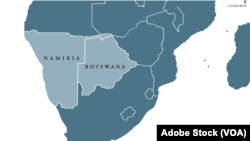The pilot run by a Dutch startup grows giant kelp to lock away planet-heating carbon dioxide, harvesting some of it to make products from cosmetics to biodegradable food packaging and biostimulants used to boost crop yields and drought resilience.
Diamond giant De Beers is one of the companies that has signed up for potential carbon credits from the project as it strives to reduce emissions in the years ahead. It is also helping fund Kelp Blue's work to develop a method to measure carbon storage by offshore kelp, needed to generate credits.
But the Luderitz project brings other benefits, too, said Daniel Hooft, 48, a former offshore engineering specialist at oil major Shell who jointly founded Kelp Blue in early 2020 as COVID-19 spread around the world.
"Underwater, it's a big forest full of creatures ... it's really teeming with life," Hooft, the company's CEO, told the Thomson Reuters Foundation on the deck of a boat used to monitor the offshore kelp forests.
Giant kelp, the biggest of the brown seaweed varieties, can boost marine biodiversity and protect wildlife, research has shown - and the Benguela ocean current that flows off the shores of Luderitz offers ideal conditions for growing it.
The kelp grows up from the seabed, about 10 meters (33 feet) deep, to the surface, forming towering canopies of "beautiful green, golden, photosynthetic leaves," said Hooft.
So far, Kelp Blue has grown two forests off the rugged coast of Luderitz. Since December, its team of marine biologists and divers has also set up an experimental kelp forest in Shearwater Bay.
By regularly harvesting the top of the kelp's canopy, the company hopes eventually to produce 150 tonnes of giant kelp per hectare each year to supply its processing department.
Researchers say kelp forests act as giant carbon sinks and can help curb global warming by sucking carbon dioxide from the atmosphere and locking up that carbon in the ocean.
In a recent research paper, the U.N. Environment Program (UNEP) calls kelp an "important nature-based solution ... to tackle climate change" because of its ability to store carbon.
The report also cites its potential to generate "blue carbon" credits.
Blue carbon is the carbon captured and sequestered by marine ecosystems - and the credits generated by projects to protect, restore and expand these environments are in high demand.
In a country where youth unemployment is as high as 50%, with few skilled jobs for marine experts, the project has also turned the far-flung southern town into an unlikely beacon for green jobs.
Iriya Jona, 27, a fisheries studies graduate who was offered a job by Kelp Blue in Luderitz about 18 months ago, leads a team of several employees.
"Initially we thought only 25 people would be hired. Now, we have around 42 employees in Luderitz. And we are expanding," said Jona, one of numerous local marine biologists to find jobs in the town, also the site of a company laboratory.
The project could also help Namibia's drought-stressed farmers through the production of biostimulants to boost crop yields amid more frequently occurring droughts due to climate change.









Forum